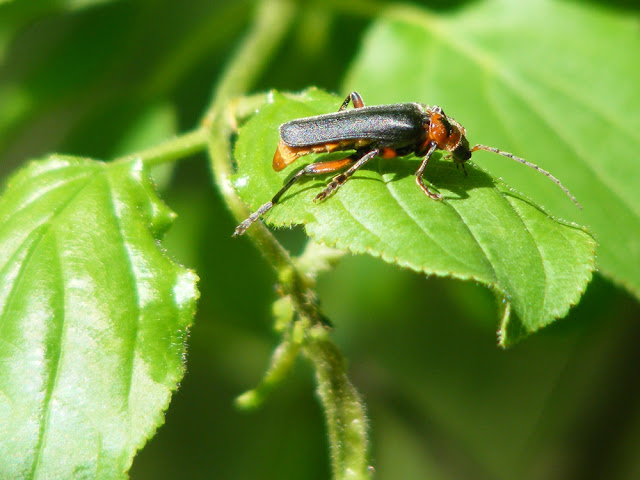These beetles all emerge once the days are warm enough and there is enough food for them. In the case of one it needs nice toxic buttercups and wood anemones to be juicy with fresh new spring shoots. In the case of another it needs lots of nutritious pollen on flowers it can burrow into. These were all photographed on the Eperon du Murat nature reserve at Ferriere-Larcon on 13 May 2023.
 |
| White Spotted Rose Beetle Oxythyrea funesta (Fr. Cétoine grise) on a Field Scabious Knautia arvensis (Fr. Knautie des champs). |
The White Spotted Rose Beetle is present practically all over Europe. The larvae are about 30mm long and eat decaying matter and plant roots as well as wood. They live underground until emerging as adults in the spring. When they are newly emerged they are covered with a white bloom which quickly wears off, leaving just the small spots you can see in this photo, and revealing the slightly greeny bronzey black base colour. The adults are considered a pest by gardeners and orchardists as they don't just eat pollen, but sometimes whole buds. Their favourite flowers are fruit tree blossom, roses and irises, and they are particularly attracted to pale coloured flowers. They only have one natural predator, the parasitic Hairy Scoliid Wasp Scolia hirta (Fr. Scolie hirsute), a species which is in decline, resulting in White Spotted Rose Beetles being increasingly abundant. Treating them with an insecticide is ineffective, so if they are causing unacceptable damage in your garden, the best way of dealing with them is to pick them off in the early morning, when they are too cold to evade you, and taking advantage of how visible they are on pale flowers.
 |
| Violet Oil Beetle Meloe violaceus (Fr. Méloé violet), female, on a buttercup Ranunculus sp (Fr. Renoncule). |
Violet Oil Beetles are parasites of bees and they have quite a complicated life cycle. Females like this one can be recognised by their hugely distended abdomens. The first stage larvae are called triangulins. They are equipped with large flat hooked feet which allow them to scale a flower stem and lie in wait for a bee to latch on to. The second stage larvae look like ground beetle larvae and they live in the bee's nest. During their next stages they look like chafer larvae. At first they eat the food supplied by the bees for their own larvae, then they are more mobile and become carnivorous. For their final two stages they bury themselves in the ground and finally transform into an adult beetle. The adults live in flower rich meadows, on forest tracks and woodland edges. They are very visible in the early spring, on the ground, when they are feeding or digging holes in which to lay their eggs. If the beetle feels in danger it will release a toxic orange liquid from its mouth. Both larvae and adults are toxic, as a result of the adults eating toxic Ranunculus spp. The species is considered to be threatened, and although not protected in France, they are monitored carefully.
 |
| Rustic Sailor Beetle Cantharis cf rustica (Fr. Moine) on Dogwood Cornus sanguinea (Fr. Le Cornouiller sanguin). |
The Rustic Sailor Beetle is abundant in Europe, from France to Russia, found in forest clearings, prairies and woodland edges. It is a carnivorous species, visiting flowers, especially umbellifers, to hunt other insects attracted by the flowers. The photo is probably this species, but there are other lookalikes and I can't be sure of the identity from this photo alone.

No comments:
Post a Comment